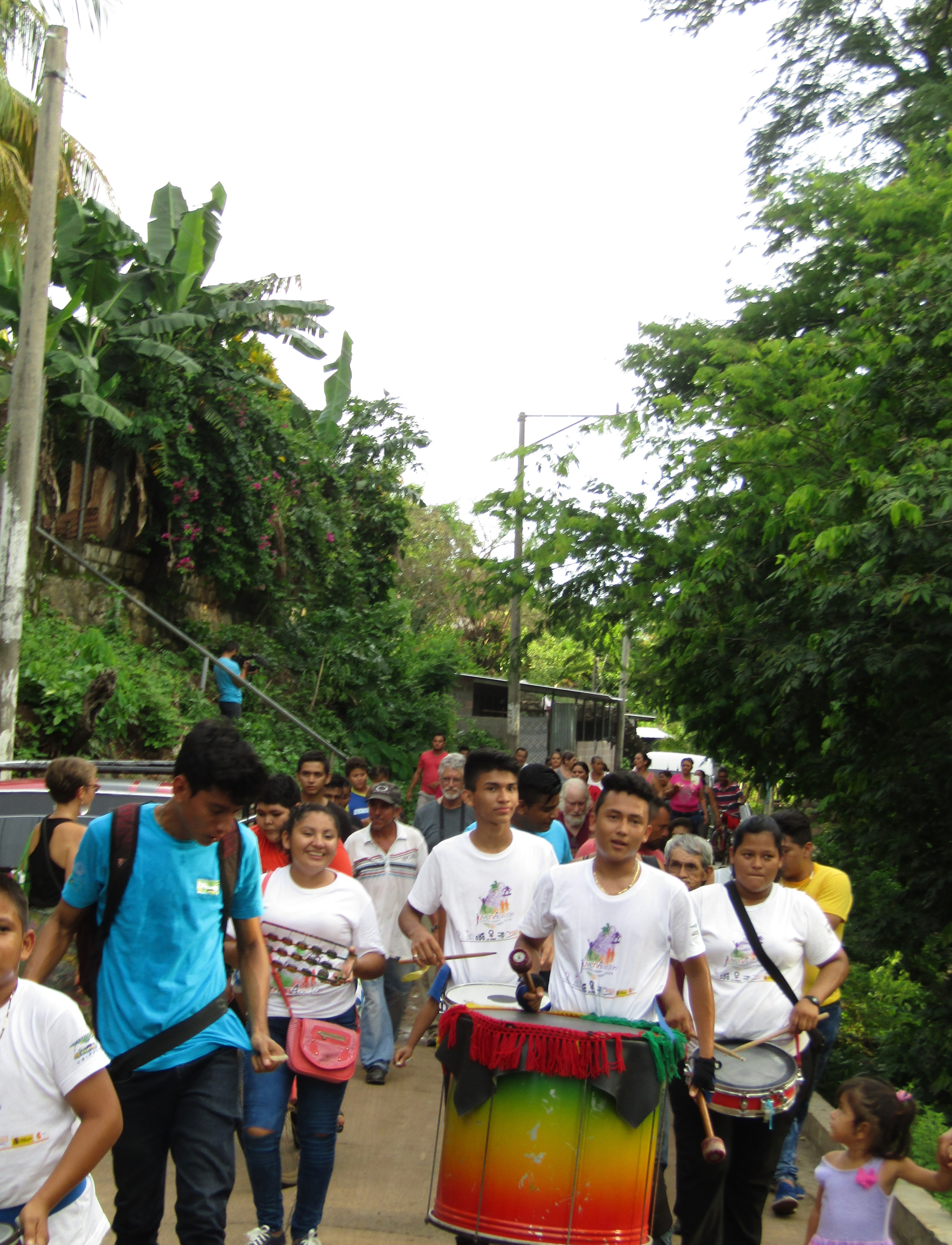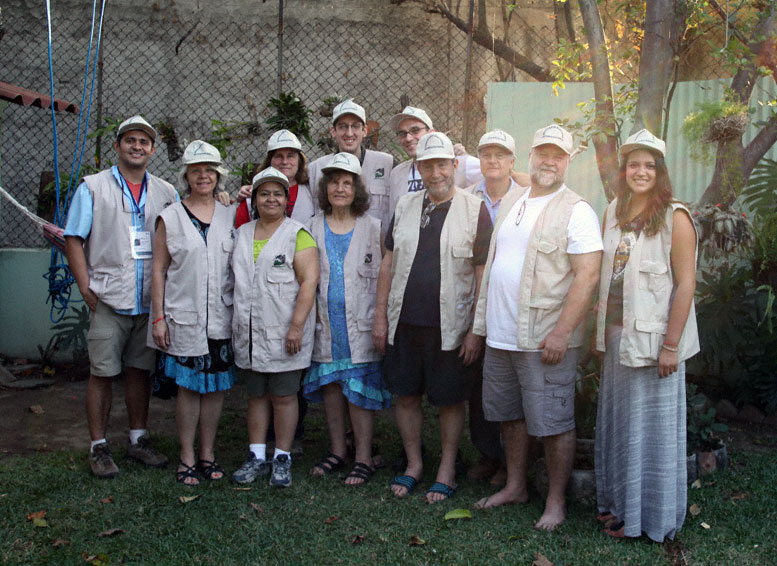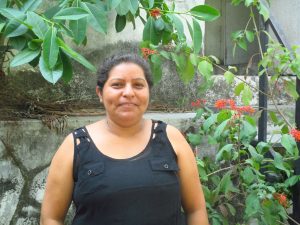Delegations
Gianella´s Delegation Experience in El Charcon 2015
The plane landed. Applause echoed from the back of the Beoing 757 aircraft, and quickly migrated to the front. What a fitting moment – after painstaking planning and preparation, I had arrived! I bid the friendly passenger who sat next to me a warm farewell, and eventually met with Suzanne Geoghegan, president of the Binghamton-El Charcón Sister City Project. It was the beginning of an exciting week!
After traveling to Honduras with Cornell University’s Global Medical/Dental Brigade in May of 2014, I was focused on gaining a more holistic perspective on the circumstances surrounding the quality of public health practices, and on socioeconomic mobility in Central America. I also wanted to learn how people with limited resources effectively organize themselves within their communities, and the very real challenges that people face in obtaining and maintaining a healthy lifestyle. The trip to Honduras with Global Brigades certainly piqued my interest in international health and development, but living and interacting with members of the community in El Charcón helped to further define, what I have called, my personal “Theory for Change” – a mantra as it relates to becoming a professional in service to the underserved.
I learned about the Binghamton-El Charcón Sister City Project in 2014 at a speaking tour sponsored by the local Citizen Action of New York, and hosted by U.S.-El Salvador Sister Cities and the Peace and Justice Center of Catholic Charities. Here was an opportunity to get up close and personal with a close knit, well organized community, whose relationship with Binghamton extended beyond the detrimental effects of civil war and economic depravity. Community organizer and U.S.-El Salvador Sister Cities staff member, Cori, described some of the many push factors that often force Salvadorans to pursue illegal entry into the United States. The circumstances of the individuals and families described were often severe, and the stories challenged us to think beyond the common misconception that immigration is a one-sided issue, especially as the media continued to place illegal immigration into focus during the Honduran child migrant crisis in late 2014. Although the founding of U.S. El-Salvador Sister Cities was originally part of an effort to reestablish communities and improve relations between the United States and El Salvador as the civil war came to a close, it was made clear to me during this presentation that this organization still has a place amidst the problems associated with social and economic instability caused in large part by intrusive U.S. foreign polices like CAFTA (Central America Free Trade Agreement).
Throughout my involvement with the Binghamton-El Charcón Sister City Project, Suzanne has been my biggest advocate. She was the liaison between myself and U.S.-El Salvador Sister Cities in-country staff, Catie Johnston, who effectively considered my interests in the area of community health and wellness and the effects of emigration on family structure. Due to extenuating circumstances, our delegation was comprised of only two – myself and Suzanne – which allowed for a more customized itinerary. Catie did an amazing job making sure that every day was fun, interactive and very interesting. Upon arrival to the airport, Suzanne and I finally met Catie, who told us more about her background, her routine, and what inspired her to do the work that she does. I was completely amazed by how seamlessly Catie appeared to function in El Salvador. We spent the night at a hotel, then arose bright and early the next day to begin our adventure.
After breakfast and orientation, we drove through the buzzy downtown market filled with many interesting sights and sounds, eventually making our first stop at the Catedral Metropolitana De San Salvador. This was an important site, with a history centered greatly on the events surrounding the assassination of recently beatified Archbishop Óscar Romero on March 24th, 1980. Downstairs in the Catedral, we silently observed Romero’s tomb as we stood at his final resting place. Flowers and written messages littered the surrounding area of the tomb. Later that day we were also able to visit Divine Providence Hospital, known locally as El Hospitalito, where Romero lived and was murdered. Romero’s modest residence was striking, as were the photos on the wall that depicted the gruesome nature of the crime that occurred, and the events that soon followed. Although Romero was and still is a politically controversial figure in El Salvador, his legacy remains that he singlehandedly became the voice of the voiceless in standing against the atrocities committed during El Salvador’s 12-year civil war.
Other happenings on the first day included: a tour of San Salvador’s upscale Multiplaza shopping mall, tasty lunch at a relaxed restaurant where we met with Emily Carpenter who would replace Catie as the new guide of our delegation, meeting with the CRIPDES Sur team, and enjoying a fabulous welcome celebration once we arrived in El Charcón. Nothing could have prepared me for the extraordinary welcome we received! I recall a moment of speechlessness as community members poured into la casa comunal. There was music, dancing, and lots of ice-cream. All of us had a blast! We would later meet the members of the Community Council – la Junta Directiva – who made it all happen.
Just prior to all of the festivities, Suzanne and I met with CRIPDES Sur. This was an important experience, because CRIPDES is the national grassroots organization in El Salvador that works in partnership with U.S.-El Salvador Sister Cities in order to make delegations happen. I learned that CRIPDES, also known as the Association for the Development of El Salvador, has specialized in the advancement of ailing rural communities through organizing, outreach and advocacy since 1984, during the heights of civil war. CRIPDES Sur, one of the five branches of national CRIPDES, appeared to be very effective in the summoning, development and implementation of many initiatives, due to the dedication of extremely motivated members who were all deeply rooted in a sense of community. Without the organizing of CRIPDES Sur, a majority of the events that were planned in our itinerary would not have been realized. We met with the vibrant Zulma Hernández, supervisor of CRIPDES Sur and member of the CRIPDES national board, Ana Deisy who directed the youth scholarship program, Cintia González who supervised training and youth programs, and Reina Estela Andes who was in charge of the women’s savings and credits groups. In addition, there was an undeniable focus on feminine leadership and empowerment within CRIPDES Sur, as was expressed through the extensive impact of the microfinance and business enterprise aspect of the women’s savings and credits group.
After the festivities ended, we spent some time getting settled in. Both host families played a major role in our welcoming experience. One family provided a place for Suzanne, Emily and I to stay, and another prepared three deliciously home-cooked meals for us every day. The Junta Directiva and many community members were all well aware of our daily activities, which enhanced our community experience. We officially met with the Junta Directiva, comprised of the water, youth, sports, (women’s) savings, and pastoral committees. Official positions – such as president, treasurer and secretary – were also held in order to facilitate internal operations. I was truly impressed by the level of organization that existed, and the dedication of the leaders involved. Other memorable experiences in El Charcón included an energetic soccer match with the women’s committee, a community tour, the youth mural project, an informal lecture on the traditional medicinal uses of local plants like Chichipinse, a visit with officials at the community school, and an entertaining farewell fiesta!
We were able to engage in many meaningful experiences outside of the El Charcón as well, including a meeting with the mayor of La Libertad, the province in which lies the community of El Charcón, a meeting with the director of a local health clinic, and a tour of a maternity house in la Libertad. The maternity house, referred to as Hogar de Espera Materna, was one example of a few maternity houses erected by the government due to previously high levels of maternal and infant death. It was explained that the goal of maternal homes such as this one is to take pregnant women out of rural communities and bring them closer to hospital care as their due dates approach. This was also pointed out by the local health clinic director, Dr. Benavides. Dr. Benavides appeared to be very busy but gave a well-thought-out and extremely informative presentation about the progressive healthcare reforms enacted by the previous FMLN government, the goals set forth by the current health care system, the history and direction of the current clinic, the logistics and operational capacity of running a “level 1” clinic, the types of ailments and diseases often encountered, and the preventative measures being taken to reduce illness. We were all very impressed by what appeared to be the extension of comprehensive coverage via the current health care system; services had been extended to low-income communities, with a strong emphasis placed on reaching remote areas of the country where basic health care needs were most likely not being met.
Overall, my experience with the Binghamton-El Charcón Sister City Project has brought to my attention a unique understanding of solidarity, which is a necessary component when one considers entering and working in an underserved community. I have learned that respect, humility, accompaniment, and deep appreciation for any perceived social or cultural differences are all at the heart of my mantra – not expertise in any particular subject. Suzanne had a wonderful grasp on this idea, and it was amazing to witness how much the people of El Charcón responded to us both, as they valued the moral support from their sister city. One of the most clarifying moments of my visit was when I was able to internalize how much people of El Charcón genuinely loved their community and their culture. In fact, push factors seemed to outweigh pull factors in circumstances surrounding emigration to the United States. Some of the immediate challenges the community faced were the effects of drought, little support from the new mayor, an empty medicine box, lack of adequate transportation services, and lack of employment opportunities. Despite the circumstances, however, everyone who was young and able desired to become a success within their community. Suzanne and I met with many families, and we listened to their stories. There was Graviel, who lay in his bed, paralyzed from the waist down after a terrible fall two years ago; there was Don Humberto’s son, who described his experience on a costly two week journey to the United States before being forced to return to El Salvador; there was Edgardo, who had been deported and is unable to see his two children who currently live in the United States; there were many older community members who had established themselves in El Charcón after the war and had seen the community blossom into what it is today. This delegation has provided confirmation in regards to my future career goals and has strengthened my confidence and ability to operate within underserved communities both at home and abroad.
In conclusion, I would like to thank Suzanne Geoghegan for her unyielding support throughout this endeavor. I would also like to thank Catie Johnston, Emily Carpenter, and all of the U.S.-El Salvador Sister Cities staff involved in making this unique opportunity a reality. I would finally like to thank Broome County Peace Action and the Southern Tier Peacemakers Fund for providing a generous grant which assisted me on this amazing journey.
Watch the video of Gianella´s delegation here!



